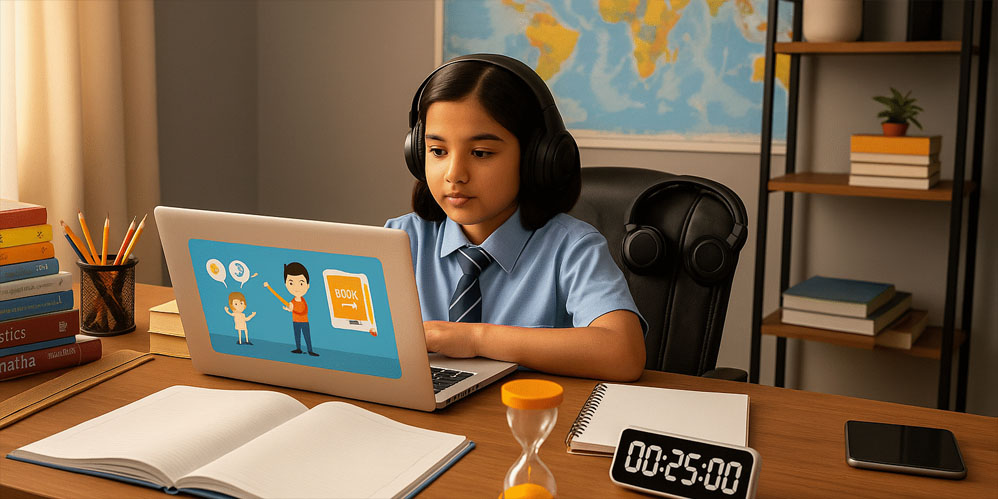Let’s be honest: you sit down to study for a test, but somehow your hand magically grabs your phone “just for a minute.” Thirty minutes later, you’re deep into cat videos, trending reels, and a conspiracy theory about pineapples on pizza.
But somewhere between “just five more minutes” and “oops, it’s midnight,” schoolwork quietly takes a back seat. Sound familiar?
Balancing screen time and study time is one of the biggest challenges students face today. It’s not just about being disciplined, it’s about being smart with your time, energy, and attention.
This blog isn’t here to lecture you. It’s here to help you figure out how to balance screen time and study time so that you don’t burn out, fall behind, or miss out on either fun or future goals.
Why Screen Time Feels So Addictive
We get it. Screens are part of life. Even studying involves screens these days. But like anything, too much of it can tip the balance.
Here’s what too much unstructured screen time might lead to:
- Trouble focusing during lessons
- Late-night scrolling = sleepy mornings
- Less time for hobbies, reading, or playing outside
- Forgetting what “offline fun” even looks like
But here’s the thing: knowing why screens feel addictive helps you take back control. It’s not about guilt. It’s about awareness. When you realise your brain is just responding to clever design, it’s easier to say, “Okay, I need a break.”
What Makes ‘Study Time’ Really Count?
Let’s break the myth: Studying for hours doesn’t always mean studying well.
Effective study time means:
- No distractions (yes, even background videos)
- Focused attention (ideally 25–45 minutes sprints)
- Clear goals (‘Finish Math worksheet’ > ‘Study Math’)
- Breaks in between (your brain needs those!)
You don’t need to cut out screen time completely. You just need to protect your study time like it’s your favourite playlist: undisturbed, high quality, and your own.
Tips for Balancing Screen Time with Study Time
You don’t need to cut out screen time. You just need to balance it. Here’s how you do it:
1. Set screen rules, but make them yours.
Decide your screen boundaries together with parents. When you’re part of the plan, you’re more likely to stick to it.
2. Use the 45/15 rule:
Study for 45 minutes, take a 15-minute break (that’s when you check your phone).
3. No screens before school and bedtime.
Your brain needs a calm start and a calm finish. Scrolling right after waking up or before sleeping messes with your focus and rest.
4. Use apps that limit other apps.
Irony? Maybe. But some apps or even built-in focus modes can help you stay on track and limit distractions.
5. Have a ‘no-screen’ challenge with friends.
Gamify it! See who can go 2 hours without picking up their phone and finish homework. Winner picks the next snack.
Smart Screen Time: Using Devices to Learn, Not Just Scroll
Not all screen time is equal. Here’s the twist: you can make screen time productive by turning devices into tools instead of just distractions.
- Listen to audiobooks or subject-specific podcasts
- Watch explainer videos for tricky topics
- Use apps that quiz you on the go
- Try AI tools to clarify concepts
It’s all about using tech to support your learning, not replace it.
Creating Your Own Balanced Routine
Every student is different. Some need more time to unwind after school. Others like to get homework out of the way first.
Try making a custom screen-study planner:
- When am I most alert? (That’s your best study time)
- What screen activities help me relax? (Keep those)
- What eats up my time with nothing useful? (Cut back there)
Balance doesn’t mean equal hours. It means knowing when to log in and when to log out.
Signs You’re Getting the Balance Right (Or Not)
You’re doing great if you:
- Finish homework without last-minute panic
- Still have time for hobbies or real-life hangouts
- Sleep on time and wake up fresh
- Use screen time for both fun and learning
You might need a change if you:
- Are constantly tired or distracted
- Rush homework or forget it often
- Feel cranky when not on a screen
- Can’t recall what you studied yesterday
If any of this rings a bell, don’t panic. It just means your balance needs a little tune-up.
Conclusion: What Shraddha Believes and How We Help
At Shraddha Children’s Academy, we understand that screens are part of a student’s world. Rather than restricting or criticising, we teach balance through habits, awareness, and thoughtful use of technology.
Our teachers encourage mindful screen time and smart study strategies. In fact, our learning model blends digital tools with offline activities so students get the best of both worlds. Whether it’s online quizzes, interactive lessons, or handwritten notes, every student gets a learning plan that suits them.
We also work closely with parents to help students build healthy routines that stick in school and at home.
That’s why Shraddha is considered among the best schools for modern learners, a place that values academics, mental health, and digital balance equally.
If you’re looking for one of the top schools that teaches students how to think, not just scroll, you’ll find it here. And when it comes to finding a place where your child’s development matters more than just marks, Shraddha stands proudly among the good schools that do it right.
You’ve Got This
Balancing screens and studies isn’t about being perfect. It’s about being aware. Start small, stay consistent, and don’t be afraid to ask for help from teachers, parents, or even friends.
And remember: your brain isn’t just here to scroll, it’s here to shine.



